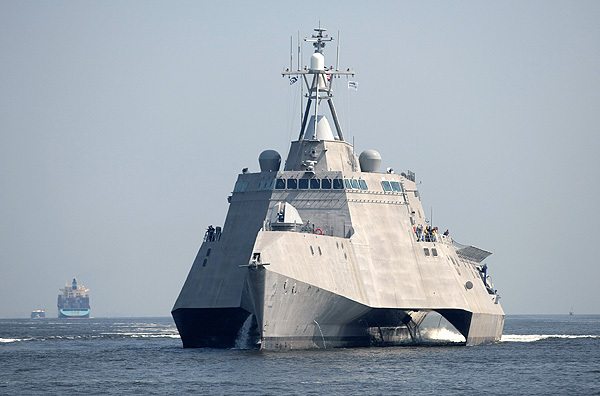The U.S. Navy is often referred to as America’s away team because we combat threats around the globe before they affect us at home. At the very core of Navy’s “away game” is our ability, in partnership with the Marines, to carry out expeditionary warfare– operations mounted from the sea, usually on short notice, consisting of forward deployed, or rapidly deployable, self-sustaining naval forces tailored to achieve a clearly stated objective. The following blog is the second in a three part series on the current status of Expeditionary Warfare programs and capabilities.
- The Littoral Combat Ship (LCS) is needed to establish and maintain dominance in the littorals, a critical part of the Surface Force’s ability to provide credible capability for deterrence, sea control, and power projection around the world, to deter or contain conflict, fight and win wars, and support our interests in an era of uncertainty.
- LCS is a fast, agile, networked surface combatant, designed to operate in the near-shore environment, while capable of open-ocean tasking. It is equipped to fight and win against 21st-century coastal threats such as submarines, mines, and swarming small craft.
- LCS is equipped with aviation features, large payload capacities and flexible mission configurations – that are all operated within a fast, stable and efficient sea frame.
- LCS’ shallow draft and superior speed and maneuverability allow easier access to near-shore/shallow-water areas not navigable by other classes of surface combatants.
- LCS’ modular design allows the ship to be tailored specifically for missions, including deployment of manned and unmanned vehicles – providing flexible solutions to counter evolving threats.
- LCS’ modular, focused-mission design provides Combatant Commanders the required warfighting capabilities and operational flexibility to ensure maritime dominance and access for the joint force.
- The Surface Force will continue to evolve by leveraging new technologies and operating concepts such as the revolutionary designs and crewing model currently employed. ◦The diversity provided by an LCS fleet, which includes two ship designs, greatly enhances operational flexibility and response to emergent tasking.
LCS will perform special operations support, high-speed transit, maritime interdiction operations, intelligence, surveillance and reconnaissance, and anti-terrorism/force protection.
While complementing the capabilities of the Navy’s larger multi-mission surface combatants, LCS will also be networked to share tactical information with other Navy aircraft, ships, submarines, and joint units.
As described, LCS mission packages will leverage incremental development. This will deliver increasing capability to the Fleet as threats evolve and technologies mature. Being able to rapidly upgrade is a major strength of modular design and open architecture standards – a strength that will keep these ships combat effective for the duration of their service lives.
- LCS features mission packages that allow it to adapt to changing operational needs in a short period of time, including anti-submarine warfare, mine counter-measures, and surface warfare modules; the surface warfare package includes a maritime security subset that allows the ship to conduct visit, board, search, and seizure operations.
- The first two MCM and SUW mission packages and the first ASW mission package have been delivered, and are expected to reach initial operational capability in FY2014.
- The program has an inventory objective of twenty-four (24) MCM mission packages, twenty-four (24) SUW mission packages, and sixteen (16) ASW mission packages, for a total of 64 packages.
- All three mission packages are progressing well. Additionally, we have a synchronized plan to deliver LCS seaframes with packages to meet the needs of Combatant Commanders as frigates, mine countermeasure ships, and patrol coastal combatants retire at the end of their service lives.
- As described, LCS mission packages will leverage incremental development. This will deliver increasing capability to the Fleet as threats evolve and technologies mature. Being able to rapidly upgrade the warfighting heart of LCS is a major strength of its modular design and open architecture standards; a strength that will keep these ships combat effective for the duration of their service lives.










